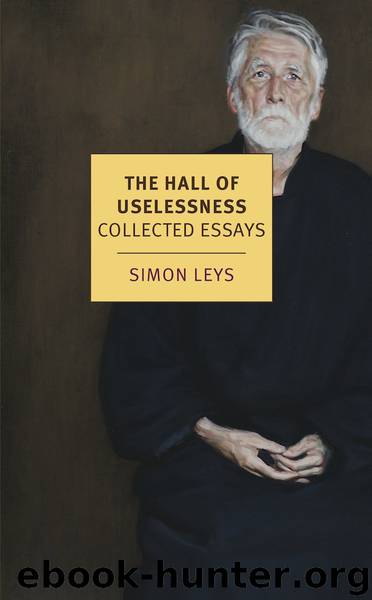The Hall of Uselessness by Simon Leys

Author:Simon Leys
Language: eng
Format: epub
Publisher: New York Review Books
Published: 2013-06-07T04:00:00+00:00
Mote then illustrates his point by sketching the history of Suzhou’s Great Pagoda—with a history going back to the third century AD, it was modified, destroyed and rebuilt many times during the ages, ending up as a twentieth-century construction:
This history is typical of China’s ancient monuments. No building with such a pedigree would count for much as an authentic antiquity even in the United States, much less in Rome. It certainly would not count for much among Ruskin’s Stones of Venice.
Mote concludes:
The point most emphatically is not that China was not obsessed with its past. It studied its past, and drew upon it, using it to design and to maintain its present as has no other civilization. But its ancient cities such as Soochow were “time free” as purely physical objects. They were repositories of the past in a very special way—they embodied or suggested associations whose value lay elsewhere. The past was a past of words not of stones. China kept the largest and longest-enduring of all mankind’s documentations of the past. It constantly scrutinized that past as recorded in words, and caused it to function in the life of its present. But it built no Acropolis, it preserved no Roman Forum, and not because it lacked the materials or the techniques. Its enduring structures of cut stone in antiquity were most characteristically burial vaults secreted underground, and, in the later imperial era, were bridges. Those vaults and bridges were called upon to serve a different level of utility; enduring public monuments to man’s achievements did not call forth those means.
Chinese civilization did not lodge its history in buildings. Even its most grandiose palace and city complexes stressed grand layout, the employment of space, and not buildings, which were added as a relatively impermanent superstructure. Chinese civilization seems not to have regarded its history as violated or abused when the historic monuments collapsed or burned, as long as those could be replaced or restored, and their functions regained. In short we can say that the real past of Soochow is a past of the mind, its imperishable elements are moments of human experience. The only truly enduring embodiments of the eternal human moments are the literary ones. [My emphasis throughout.]
Download
This site does not store any files on its server. We only index and link to content provided by other sites. Please contact the content providers to delete copyright contents if any and email us, we'll remove relevant links or contents immediately.
| Anthropology | Archaeology |
| Philosophy | Politics & Government |
| Social Sciences | Sociology |
| Women's Studies |
The Secret History by Donna Tartt(18860)
The Social Justice Warrior Handbook by Lisa De Pasquale(12143)
Thirteen Reasons Why by Jay Asher(8800)
This Is How You Lose Her by Junot Diaz(6802)
Weapons of Math Destruction by Cathy O'Neil(6152)
Zero to One by Peter Thiel(5692)
Beartown by Fredrik Backman(5609)
The Myth of the Strong Leader by Archie Brown(5429)
The Fire Next Time by James Baldwin(5252)
How Democracies Die by Steven Levitsky & Daniel Ziblatt(5133)
Promise Me, Dad by Joe Biden(5089)
Stone's Rules by Roger Stone(5028)
A Higher Loyalty: Truth, Lies, and Leadership by James Comey(4851)
100 Deadly Skills by Clint Emerson(4845)
Rise and Kill First by Ronen Bergman(4705)
Secrecy World by Jake Bernstein(4652)
The David Icke Guide to the Global Conspiracy (and how to end it) by David Icke(4629)
The Farm by Tom Rob Smith(4442)
The Doomsday Machine by Daniel Ellsberg(4420)
